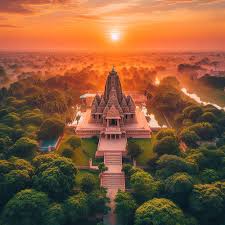Darjeeling
Darjeeling, often referred to as the "Queen of the Hills," is one of India's most famous hill stations, known for its stunning landscapes, tea gardens, colonial-era architecture, and vibrant cultural heritage. Located in the state of West Bengal, Darjeeling has been a popular tourist destination since the British colonial period.
Historical Background
Colonial Era: Darjeeling was originally a part of the Kingdom of Sikkim until the early 19th century, when it was annexed by the British East India Company. Recognizing its cool climate and strategic location, the British developed Darjeeling as a hill station and a summer resort. It became a favored retreat for the British during the hot Indian summers.
Tea Industry: The British also introduced tea cultivation in the region in the mid-19th century, and Darjeeling soon became famous for its high-quality tea, known for its unique flavor. Darjeeling tea, often referred to as the "champagne of teas," remains one of the most sought-after varieties in the world.
Development of Tourism: The British built roads, schools, churches, and the Darjeeling Himalayan Railway (DHR), also known as the "Toy Train," which played a significant role in the region's development and its popularity as a tourist destination.
Key Attractions
Darjeeling Himalayan Railway (DHR):
- UNESCO World Heritage Site: The DHR, a narrow-gauge railway built between 1879 and 1881, is a UNESCO World Heritage Site. The Toy Train, as it is affectionately known, offers a scenic ride through the hills, offering breathtaking views of the mountains and tea gardens.
- Ghoom Monastery: The railway passes through Ghoom, which is home to the Ghoom Monastery, one of the oldest Tibetan Buddhist monasteries in the region.
Tiger Hill:
- Sunrise Point: Tiger Hill is famous for its panoramic views of the sunrise over the Himalayas. On clear days, visitors can see the peaks of Mount Everest and Kanchenjunga, the third-highest mountain in the world.
Darjeeling Tea Gardens:
- Tea Tourism: Visitors can tour the picturesque tea gardens, learn about the tea-making process, and taste some of the finest teas. Estates like Happy Valley Tea Estate offer guided tours and tastings.
- Heritage Bungalows: Many tea gardens have heritage bungalows where visitors can stay and experience the colonial-era charm.
Himalayan Mountaineering Institute (HMI):
- Mountaineering Hub: Founded in 1954 by Tenzing Norgay, who along with Sir Edmund Hillary was the first to summit Mount Everest, the HMI is a premier institution for mountaineering and adventure sports. The institute also has a museum dedicated to the history of mountaineering.
Batasia Loop:
- Scenic Railway Loop: Located on the way to Ghoom, the Batasia Loop is a spiral railway track where the Toy Train makes a loop around a garden, offering stunning views of the surrounding landscape and the war memorial dedicated to the Gorkha soldiers.
Peace Pagoda:
- Japanese Temple and Pagoda: The Peace Pagoda, built by the Japanese Buddhist Nipponzan Myohoji organization, is a symbol of peace and offers panoramic views of Darjeeling and the Kanchenjunga range.
Darjeeling Zoo (Padmaja Naidu Himalayan Zoological Park):
- Conservation Center: This zoo is known for its efforts in conserving Himalayan species like the snow leopard, red panda, and Tibetan wolf. It is also home to a wide variety of flora and fauna unique to the region.
Colonial Architecture:
- Historic Buildings: Darjeeling is home to several colonial-era buildings, including St. Andrew's Church, the Darjeeling Planters' Club, and various boarding schools, which add to the town's historic charm.
Cultural Significance
- Ethnic Diversity: Darjeeling is a melting pot of cultures, with significant Nepali, Tibetan, Bengali, and Lepcha communities. This diversity is reflected in the region's festivals, cuisine, music, and dance.
- Festivals: Major festivals celebrated in Darjeeling include the Tibetan Losar, Tihar (similar to Diwali), Christmas, and the Darjeeling Carnival, which showcases local music, dance, and art.
Adventure Tourism
- Trekking: Darjeeling is a gateway to several trekking routes in the Himalayas, including the famous Singalila Ridge trek to Sandakphu, which offers panoramic views of the Himalayan peaks.
- Paragliding and Rafting: The region also offers opportunities for adventure sports like paragliding and white-water rafting on the Teesta River.
Tourism Development
- Infrastructure: Over the years, Darjeeling has developed a robust tourism infrastructure, including hotels, resorts, homestays, and eateries that cater to a wide range of budgets and preferences.
- Sustainability: Efforts are being made to promote eco-friendly tourism in Darjeeling, focusing on preserving its natural beauty and cultural heritage.





